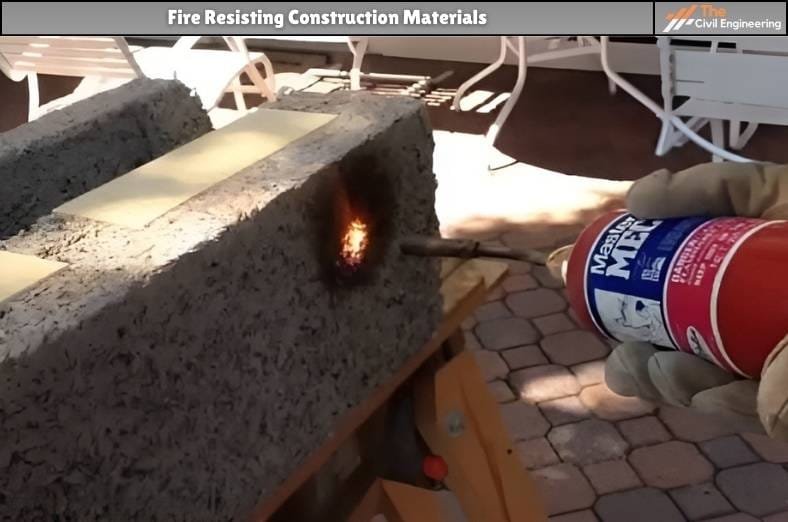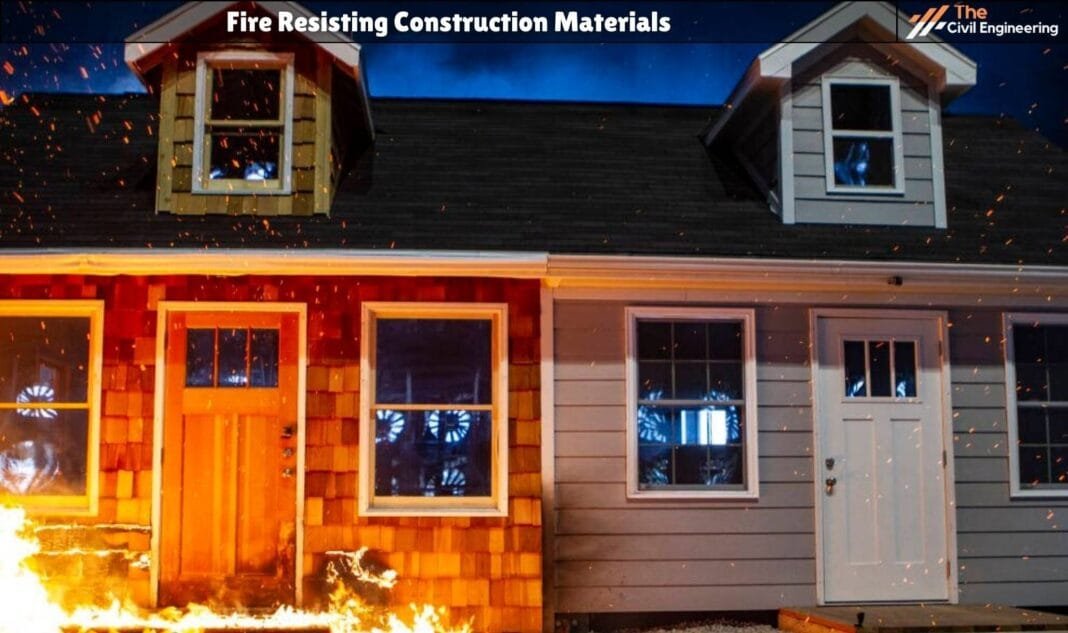In this article, we will discuss fire resisting construction materials.
1. Introduction
No building material is perfectly fireproof. Every building contains some materials (such as furniture, clothing, eatables, etc.) which can either easily catch fire or which are vulnerable to fire. However, the endeavor of the architects and engineers should be to plan, design, and construct the building in such a way that the safety of occupants may be ensured to the maximum possible extent in the event of the outbreak of fire in the building due to any reason whatsoever.
The technical interpretation of fire safety of buildings is to convey the fire resistance of buildings in terms of hours when subjected to the fire of known intensity. It should have a structural time interval so that adequate protection to the occupants is afforded. A wider interpretation of fire safety may be deemed to cover the following aspects :
(a) Fire prevention and reduction of the number of outbreaks of fire,
(b) Spread of fire, both internally and externally,
(c) Safe exit of any and all occupants in the event of an outbreak of fire, and
(d) Fire extinguishing apparatus.

2. Fire Resisting Construction Materials
The fire resisting construction materials are as follows:
2.1. Stone
Stone is a non-combustible building material and also a bad conductor of heat and does not contribute to the spread of fire. However, it is a bad fire-resisting material since it is liable. to disintegrate into small pieces when heated and suddenly cooled, giving rise to the failure of the structure. Granite, on exposure to severe heat, explodes and disintegrates. Limestone is the worst since it is easily crumbled even under ordinary, fire.
The sandstone of compact composition (fine-grained) can, however, stand the exposure to moderate fire without serious cracks. In general, the use of stone in a fire-resisting ‘construction should be restricted to a minimum.
2.2. Bricks
Brick is a poor conductor of heat. First-class bricks molded from good clay ‘can stand exposure to fire for a considerable length of time, up to temperatures of about 1200°C. Brick masonry construction, with good mortar and better workmanship, is the most suitable for safeguarding the structure against fire hazards.
2.3. Concrete
The behavior of concrete during exposure to heat varies with the nature of coarse aggregate and its density and the quality of cement. It also depends upon the position of steel in concrete. Aggregates expand on heating while ordinary cement shrinks on heating. These two opposite actions may lead to spalling of the concrete surface.
Aggregates obtained from igneous rocks containing higher calcareous content, tend to crack more while the aggregates like foamed slag, cinder, and bricks are better. The cracks formed in concrete generally extend to a depth of about 25 mm. Hence reinforced concrete fire-resistant construction should have a greater cover. In general, concrete offers a much higher resistance to fire than any other building material. Reinforced concrete structures can withstand fire lasting for several hours with a temperature of 1000°C without serious damage.
2.4. Steel
Though steel is non-combustible, it has very low fire resistance, since it is a good conductor of heat. During a fire, it gets heated very soon, its modulus of elasticity reduces and it loses its tensile strength rapidly. It is found that the yield stress of mild steel at 600° C is about ½ of its value at normal temperatures. Hence unprotected steel beam sags and unprotected columns or struts buckle, resulting in the collapse of structures.
If the surface paint on these steel components is not fire-resistant, It is essential to protect structural steel members with some coverings of insulating materials like brick, terra-cotta, concrete, etc.
Fixing steel in plate or sheet form to the structural steel framework is also effective in resisting the passage of flame. Such construction is widely used in making fire-resisting doors and windows.
| Read Also: Size-of Steel Used in Construction |
2.5. Glass
Glass is a poor conductor of heat, and its thermal expansion is also less. When it is heated and then suddenly cooled, cracks are formed. These cracks can be minimized if the glass is reinforced with steel wire netting. Thus, reinforced glass is more fire-resistant, and can resist variations in temperature without serious cracks. Reinforced glass has a higher melting point.
Even if cracks are formed, the embedded wires hold the cracked portion in position. Reinforced glass is therefore commonly used fin. fire-resisting doors, windows, done sky-lights, etc.
2.6. Timber
Timber is a combustible material. It ignites and gets rapidly destroyed during a fire if the section is small. However, if timber is used in thick sections, it possesses the properties of self insulation and slow-burning.
During exposure to fire, the timber surface gets charred; this charred portion acts as a protective coating to the inner portion. However, if the temperatures are higher than 500°C, timber gets dehydrated under continued exposure, giving rise to combustible volatile gases which readily catch fire. In order to make timber fire-resistant, the following measures are adopted :
(i) use of thicker sections at wider spacing than thinner sections at closer spacing, especially in the case of floor joints.
(ii) reducing the number of corners and area of exposed surfaces to a minimum
(iii) coating timber surface with chemicals like ammonium phosphate and sulfate, borax and boric acid, zinc chloride,
(iv) painting timber surfaces with asbestos or ferrous oxide paints, if painting is necessary. Painting these with oil paints or varnish should not be done since these paints catch fire.
2.7. Cast-iron and Wrought iron
Cast iron behaves very badly in the event of a fire. On sudden cooling, it gets contracted and breaks down into pieces or fragments, giving rise to sudden failure. Hence it is rarely used in fire-resistant buildings unless suitably covered by bricks, concrete, etc. Wrought iron behaves practically in the same way as mild steel.
2.8. Asbestos Cement
It is formed by combining fibrous asbestos with Portland cement. It has a low coefficient of expansion and has the property of incombustibility. It has, therefore, great fire resistance.
Asbestos cement products are largely used for the construction of fire-resistant partition walls, roofs, etc. It is also used as a protective covering for other structural members.
| Read Also: Cement |
2.9. Aluminium
It is a very good conductor of heat. It has very poor fire-resistant properties. Its use should be restricted to only those structures which have very low lire risks.
2.10. Plater or Mortar
Plaster is non-combustible. Hence it should be used to protect walls and ceilings against fire risks. Cement plaster is better than lime plaster since the latter is likely to be calcined during a fire. The fire resistance of plaster can be increased by using it in thick layers or reinforcing it with metal laths. Gypsum plaster, when used over structural steel members, make them better fire-resistant.
Read More: Site Plan
Read More: Partition Wall


